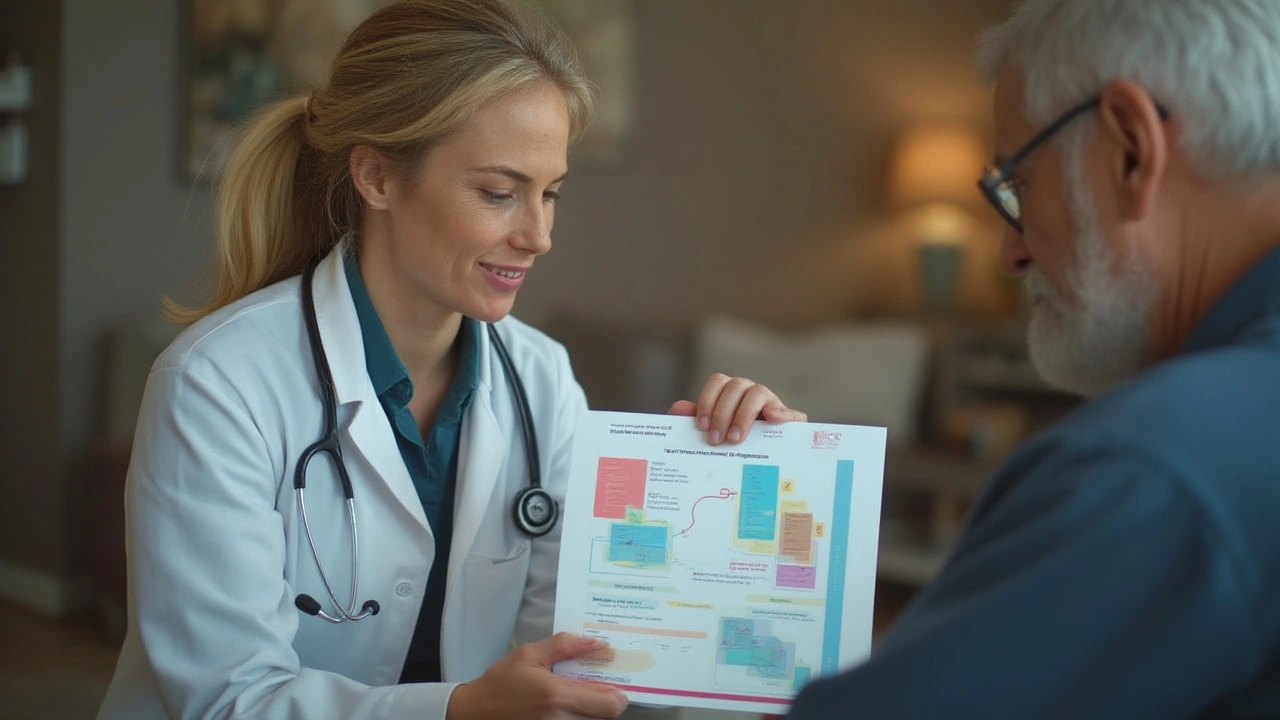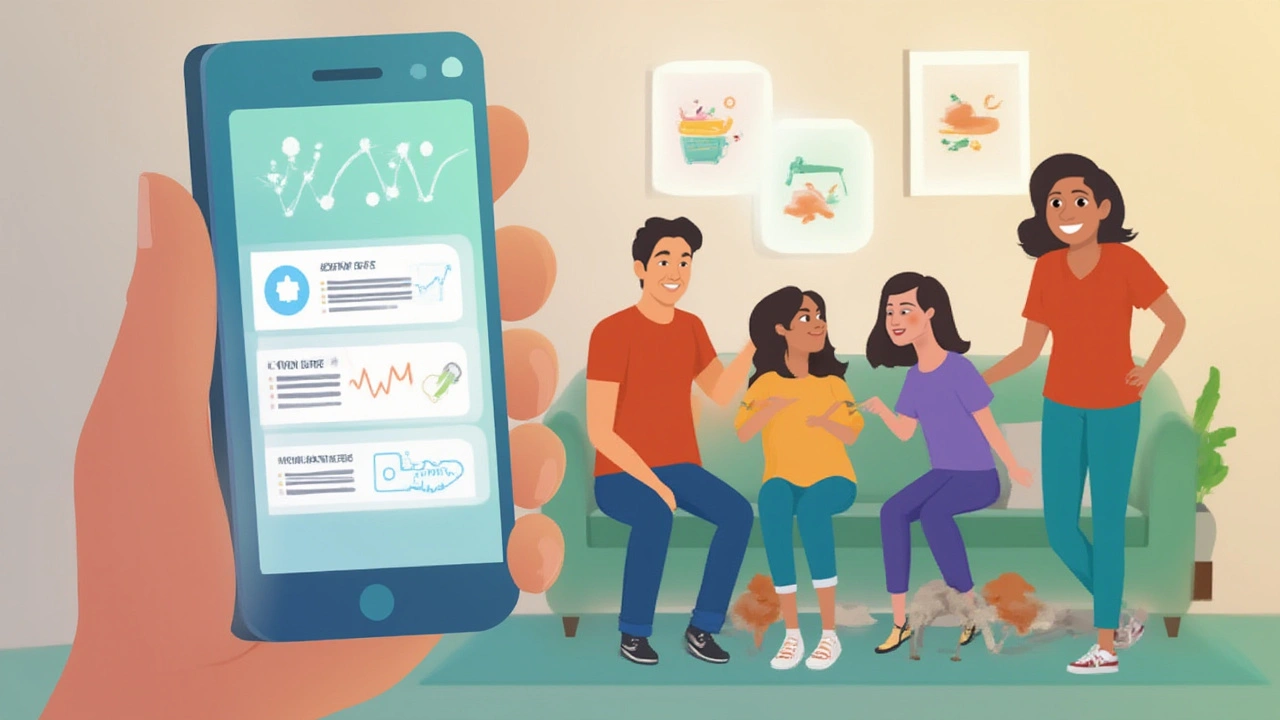If you think you can just quit metoprolol cold turkey, hold on. Suddenly stopping this heart medication is a bit like abruptly yanking the handbrake at 60 miles an hour—nobody has a good time. People don't always realize how much their body relies on metoprolol until they try to ditch it. One study out of the UK found patients who quit too quickly ended up in A&E with rapid heart rates, wild swings in blood pressure, and sometimes even chest pain. So, if you're thinking it’s time to switch off metoprolol, you need the right roadmap, not just good intentions. There’s more to this process than tossing your pills and hoping for the best.
The Science Behind Tapering: Why a Slow Exit Matters
When you've been on metoprolol for a while, your heart has gotten used to its "chill pill" effect. Metoprolol slows your heart rate and makes it easier for the heart to pump, but suddenly cutting it out confuses your system. Experts at Bristol Royal Infirmary found that patients who dropped beta blockers too quickly faced a four-fold risk of "rebound" symptoms: heart pounding, shaking hands, and sudden blood pressure spikes. That’s because your body, deprived of the steady "brake" metoprolol applies, tends to overreact.
The gold standard for stopping is tapering, meaning you reduce the dose bit by bit. But what does that actually look like? For most folks, a typical taper schedule might stretch over two to four weeks. Higher doses or longer duration, and your taper could take a little longer. Your cardiologist will usually recommend cutting your pill in half for a week, then another half, and so on, all while keeping watch for anxiety, palpitations, headaches, or chest tightness. If any of these show up, your dose cuts might slow to a crawl, sometimes by as little as 12.5mg every week.
Here’s a sample schedule for someone on 100mg daily:
- Week 1: 75mg per day
- Week 2: 50mg per day
- Week 3: 25mg per day
- Week 4: 12.5mg per day
- Stop, if no symptoms (and with doctor’s green light)
But don’t go it alone. Tapering works best with a safety net. Keep close contact with your GP or cardiologist, especially if you bump into symptoms like dizziness, chest pain, or blood pressure that resets itself to "rollercoaster" mode. Did you know about 30% of patients experience at least some minor symptoms while tapering beta blockers? That number jumps if you’ve got underlying angina or anxiety problems. If you have atrial fibrillation, your risk of relapse increases, so doctors may want extra checkups built into your plan.
Here’s where being proactive pays off. Keep a blood pressure and pulse diary. There are easy-to-use home monitors on Amazon today that connect to your phone, making charting a breeze. Jot down your readings twice a day, with notes if you feel any oddbeats, headaches, or light-headed moments. Give this info to your medical team: it helps them personalise the taper and flag any warning signs before they escalate.
What can you expect during a metoprolol taper? Some people feel nothing beyond maybe a mild bump in heart rate or a day or two of feeling a bit off. Others, particularly those with anxiety or a history of heart rhythm problems, might notice jitteriness or increased palpitations. The rule of thumb: there’s no medal for speed. Taper at your own pace, and call for help at the earliest sign of trouble. And remember to never adjust your dose or timing without a nod from your healthcare provider.
So if you thought stopping a blood pressure pill was a snooze, think again. The science says a cautious, stepwise approach isn’t just smarter—it’s genuinely safer.

Monitoring Tips: Tools for a Safe Transition
Here’s a dirty little secret you don’t hear much about—most people simply guess how their body is handling medication changes. That’s a recipe for problems, especially with a beta blocker like metoprolol. Want to keep things smooth? You need the right tools and habits to spot bumps early, before they get ugly.
Let’s talk home monitoring. With digital tech exploding, it’s never been simpler to check your own pulse and blood pressure. Arm cuffs are much more accurate than wrist models, and some smart monitors even send your readings straight to your iPhone. One NHS patient in Bristol told me his Omron monitor caught creeping blood pressure within a week of starting his taper, saving him an unexpected doctor visit.
What should you track?
- Take your pulse every morning and evening before meds, jotting down the numbers
- Diastolic and systolic blood pressure readings, with at least two checks each time
- Any skipped beats, racing heart, or pounding sensations—especially while exercising
- Symptoms like dizziness, sweating, vision changes, or chest discomfort
Make a chart or use an app so you (and your doctor) can spot trends right away. Here’s the lowdown: if you’ve got a resting heart rate suddenly rocketing past 90, or your blood pressure spikes by more than 20 points from baseline, call your GP. Most common issues in the taper phase are minor: a bit of jitter, a small raise in heart rate, maybe a faint headache. But severe chest pain, fainting, or crushing dizziness? Those are A&E territory.
Avoid caffeine binges, sudden exercise, or late-night stressors while tapering off. Even a sleepless night can throw your rhythm out if your nervous system is adapting to less beta blocker in the mix. Track your sleep, too—lots of folks report some insomnia as their body “wakes up” without the medication dampening things down.
Want a quick way to spot trouble? Use the “Talk Test.” If you’re walking and can’t get a full sentence out without panting, or your heart is thumping louder than usual, it’s a red flag. Don’t tough it out. Call for medical advice. Your safety checklist during withdrawal should include:
- Pulse and BP monitoring twice daily, at the same times
- Weekly phone or video check-ins if you’re at higher risk
- Written symptom journal—simple as texting yourself notes
- Emergency plan—who to call, where to go if symptoms escalate fast
Here’s a handy table showing what changes are normal… and what needs urgent follow-up:
| Finding | Normal | Needs Assistance |
|---|---|---|
| Resting Pulse | Up to 10 bpm higher than baseline | >20 bpm rise or >100 bpm |
| Blood Pressure | Up to 15/10 mmHg higher | >20/10 higher or symptomatic |
| Symptoms | Mild headache, mild jitter | Severe chest pain, fainting |
| Exercise tolerance | Unchanged or slightly reduced | Marked shortness of breath |
Taking the time to measure and record your readings isn’t just busywork; it’s the difference between a smooth off-ramp and a medical mess. The right tools and habits mean you catch issues fast, work with your doctor seamlessly, and steer well clear of the nasty surprises.

Alternative Medications: What Might Replace Metoprolol?
Let’s say you and your cardiologist agree: it’s time for something new. Maybe you’ve got side effects, or your condition changed, or you’re aiming for fewer pills. So what comes after metoprolol? Here’s the thing—there’s no “one size fits all.” Your next med depends on why you were taking metoprolol in the first place. Did you have it for high blood pressure, for an irregular heartbeat, or post-heart attack protection?
Here’s a quick run-through of typical alternatives:
- Bisoprolol: A cousin of metoprolol, but longer-acting and sometimes easier on the sleep cycle. Used a lot in the UK for heart failure and arrhythmias, especially for those with troublesome side effects from metoprolol.
- Nebivolol: If you have asthma or bad circulation, nebivolol causes less “beta blocker fatigue” and fewer cold hands. It’s also gentler on the lungs and often less likely to cause impotence in men.
- Atenolol: Somewhat out of fashion, but still offered to certain folks with less risk of central nervous system side effects. Not the first pick but handy in certain settings.
- Calcium channel blockers (like amlodipine): Often plugged in for blood pressure or angina, especially if beta blockers don’t play well with your system.
- ACE inhibitors or ARBs (perindopril, losartan): Great for blood pressure and kidney protection, especially in diabetics or patients with heart failure.
How do you and your doctor decide what’s best? Expect a game of matching risks to benefits. For instance, if you have asthma, certain beta blockers are shunned in favour of nebivolol or a calcium channel blocker. If you broke out in a rash from metoprolol, your doctor may test a different drug class instead of risking another beta blocker.
When you switch, it usually goes one of two ways: either you overlap the new med as you taper down the metoprolol (so there’s no gap), or you swap one for the other in stages. For most, doctors start low and increase the new med as your old dose gets lower, keeping your vital signs on a tight leash. Don’t be surprised if you’re asked to come in for an ECG or a quick heart ultrasound once you’re stabilized—or even wear a Holter monitor for a day or two to make sure all’s well.
Worried about side effects? Ask about lifestyle options too. Some people have been able to ditch medication altogether with diet tweaks, more walking, or losing a bit of stubborn weight. But, if your heart condition is moderate or higher risk, medication is usually part of the long-term picture.
If you’re hunting for more practical info about choosing an alternative to metoprolol, there are some good UK-based guides that break down the nuances. You’ll find patient stories and up-to-date clinical comparisons—helpful when you want to arrive at your next appointment loaded with questions.
When you switch your medication, even small changes can create surprisingly big reactions for a few days. A fresh prescription might feel different in your system; it’s not unusual to notice your energy, sleep, or even dreams alter. Track these changes in your symptom diary. The more info you share with your GP, the smoother your new med experience will be. Transparency keeps the surprises manageable and your doctor can fine-tune your plan on the fly.
Nobody should have to face a heart medication switch alone or in the dark. Whether you’re worried about symptoms, tracking your stats, or scanning labels in the pharmacy queue, the key is customisation. Taper slowly, monitor fiercely, and don’t be afraid to ask about every last alternative. Your heart’s too important to leave this stuff to guesswork.







Comments
Chelsey Gonzales
July 13, 2025 AT 11:19 AMi literally panicked and stopped my metoprolol cold turkey last year bc i thought it was making me sleepy all the time. woke up with my heart in my throat and had to drive to urgent care. never again. this post saved my life tbh.
MaKayla Ryan
July 14, 2025 AT 05:24 AMWhy are we even letting people quit meds like this? In my country you’d need a court order to stop something that keeps your heart from exploding. This is why America’s healthcare is a joke - people think they can just wing it with their life-saving prescriptions.
Kelly Yanke Deltener
July 15, 2025 AT 11:15 AMMy ex was on metoprolol for 7 years and when he quit cold turkey he started crying for no reason, couldn’t sleep, and swore he could hear his heartbeat in his ears. I told him to go back to the doctor but he was too proud. He ended up in the ER with a heart rate of 142. I still think about it. Don’t be like my ex. Please.
Sarah Khan
July 16, 2025 AT 09:37 AMThe physiological mechanism behind beta-blocker withdrawal is fascinating - it’s not just about heart rate, it’s about receptor upregulation and sympathetic nervous system rebound. Your body adapts to chronic inhibition by increasing receptor density, so when you remove the blocker, the catecholamines flood unopposed. That’s why symptoms aren’t just ‘weird’ - they’re biologically inevitable without tapering. The fact that so many patients don’t know this speaks to a systemic failure in patient education. We need more than pamphlets - we need mandatory pre-taper counseling, like we do with opioids. This isn’t just medical advice, it’s a public health imperative.
Kelly Library Nook
July 16, 2025 AT 20:17 PMWhile the article presents a reasonable framework for tapering, it lacks empirical citations for the 30% symptom incidence rate. Furthermore, the recommendation to use Amazon-connected monitors raises ethical concerns regarding data privacy and device accuracy validation. The NHS anecdote is anecdotal, not evidence-based. A properly structured clinical guideline would reference randomized controlled trials, not blog-style testimonials. This piece, while well-intentioned, dangerously blurs the line between medical advice and wellness content.
Crystal Markowski
July 18, 2025 AT 15:26 PMHey everyone - if you’re tapering, you’re already doing better than most. This isn’t about being perfect, it’s about being careful. Keep that journal, even if it’s just a note in your phone. And if you’re scared? That’s okay. Talk to your doctor. You don’t have to be brave alone. I’ve been there. You’ve got this.
Charity Peters
July 20, 2025 AT 15:17 PMi just stopped mine and felt fine. maybe i’m just lucky.
Faye Woesthuis
July 21, 2025 AT 19:05 PMPeople who don’t follow medical advice deserve what they get. This isn’t a game. Your heart doesn’t care how ‘empowered’ you feel.
Samantha Stonebraker
July 23, 2025 AT 05:41 AMI switched from metoprolol to nebivolol last year and honestly? My hands stopped feeling like frozen popsicles. I used to hate winter because my fingers turned white. Now I can hold my coffee without wincing. It’s not just about heart rate - it’s about quality of life. Ask your doc about alternatives. You might be surprised.
Kevin Mustelier
July 23, 2025 AT 19:57 PMlol i stopped mine bc i thought it was making me gay. turns out i was just stressed. also i cried watching a dog video. not the meds. 😂
Luke Webster
July 25, 2025 AT 14:00 PMMy dad was on metoprolol after his bypass and we tapered him over six weeks with weekly check-ins. We tracked his BP with an old-school cuff and a notebook. No fancy apps. Just consistency. He said the hardest part wasn’t the physical stuff - it was the fear. That’s why this post matters. It’s not just about the science. It’s about giving people permission to go slow. And that’s worth more than any pill.